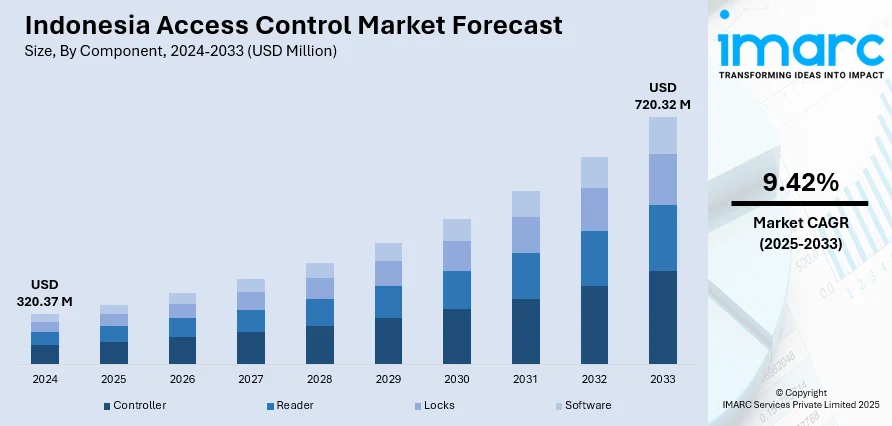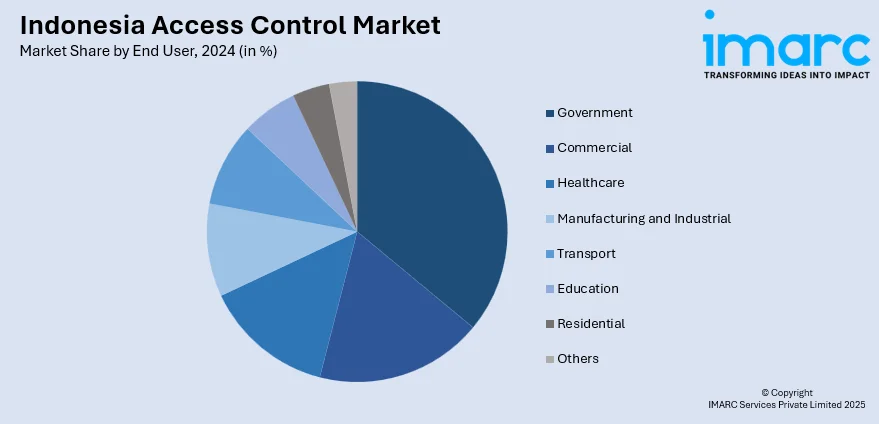
Indonesia Access Control Market Size, Share, Trends and Forecast by Component, Type, End User, and Region, 2025-2033
Indonesia Access Control Market Overview:
The Indonesia access control market size reached USD 320.37 Million in 2024. The market is projected to reach USD 720.32 Million by 2033, exhibiting a growth rate (CAGR) of 9.42% during 2025-2033. The market is driven by rapid urbanization, booming commercial real estate, and smart-city initiatives across Jakarta and secondary cities. Government mandates around critical infrastructure security and data protection encourage adoption of electronic credentials and centralized management. Rising MSME digitization, e-commerce logistics growth, and 24/7 retail drive need for scalable, cloud-based systems. Integration with CCTV, biometrics, and time–attendance improves ROI. Falling hardware costs, mobile-first users, and OPEX-friendly subscriptions further Indonesia access control market share thus upgrading keys to smart, audit-ready solutions, nationwide demand.
|
Report Attribute
|
Key Statistics
|
|---|---|
|
Base Year
|
2024
|
|
Forecast Years
|
2025-2033
|
|
Historical Years
|
2019-2024
|
| Market Size in 2024 | USD 320.37 Million |
| Market Forecast in 2033 | USD 720.32 Million |
| Market Growth Rate 2025-2033 | 9.42% |
Indonesia Access Control Market Trends:
Government Regulations and Compliance Requirements
Government security mandates and compliance frameworks is a key driver of the Indonesia access control market , particularly in critical infrastructure, banking, and data centers. Regulations require strict control over who can enter secure zones, coupled with audit trails to track movements during incident investigations. The Personal Data Protection Law (PDP Law) and sector-specific guidelines in energy, finance, and telecommunications push organizations to adopt systems that integrate with identity management and cybersecurity protocols. Compliance inspections often favor digital or biometric solutions over manual security logs due to their greater reliability and accountability. Additionally, public facilities like airports, seaports, and government offices are modernizing security in line with international standards, creating significant procurement opportunities. These regulatory pressures are accelerating the replacement of outdated lock-and-key mechanisms with sophisticated, networked access control technologies that ensure adherence to legal and operational standards.

To get more information on this market, Request Sample
Urbanization and Infrastructure Development
Indonesia’s rapid urbanization, especially in metropolitan areas like Jakarta, Surabaya, and Bandung, is fueling Indonesia access control market growth. Jakarta alone is projected to reach around 11.5 million residents, increasing the need for regulated entry, crowd management, and perimeter security. Large-scale infrastructure projects including office towers, mixed-use developments, transport hubs, and industrial estates require modern, integrated security systems. Developers increasingly consider access control a value-added feature to attract tenants and comply with safety certifications. Government initiatives, such as the National Medium-Term Development Plan, promote smart building construction, naturally integrating advanced access control technologies. With urban migration expected to continue for decades, both public and private sectors are prioritizing investment in secure, efficient entry systems. This drives sustained demand for solutions ranging from RFID and biometrics to cloud-based, remotely managed platforms, ensuring safety, efficiency, and compliance across growing urban centers.
Technological Integration and Cost Efficiency
The convergence of access control with other technologies such as CCTV, intrusion alarms, biometric authentication, and cloud-based management—is a major growth catalyst in Indonesia. Businesses seek unified platforms that not only secure premises but also deliver analytics, attendance tracking, and visitor management from a single interface. Cloud-based and mobile-enabled systems reduce upfront capital expenditure, replacing costly physical infrastructure with subscription models that are attractive for SMEs and large enterprises alike. Falling hardware costs, increased local manufacturing, and import channel efficiency make advanced devices more affordable. Furthermore, integration enables remote monitoring, instant credential revocation, and scalability, aligning with Indonesia’s mobile-first digital culture. For organizations with distributed sites such as retail chains, logistics providers, and educational institutions this approach reduces operational costs while enhancing oversight, making technologically integrated access control a compelling investment for long-term efficiency and security.
Indonesia Access Control Market Segmentation:
IMARC Group provides an analysis of the key trends in each segment of the market, along with forecasts at the country and regional levels for 2025-2033. Our report has categorized the market based on component, type, and end user.
Component Insights:
- Controller
- Reader
- Locks
- Software
The report has provided a detailed breakup and analysis of the market based on the component. This includes controller, reader, locks, and software.
Type Insights:
- Card Based
- Contact
- Contactless
- Biometric Based
- Fingerprint
- Face Recognition
- Face Recognition and Fingerprint
- Iris Recognition
- Others
A detailed breakup and analysis of the market based on the type have also been provided in the report. This includes card based (contact, contactless) and biometric based (fingerprint, face recognition, face recognition and fingerprint, iris recognition, and others).
End User Insights:

- Government
- Commercial
- Healthcare
- Manufacturing and Industrial
- Transport
- Education
- Residential
- Others
A detailed breakup and analysis of the market based on the end user have also been provided in the report. This includes government, commercial, healthcare, manufacturing and industrial, transport, education, residential, and others.
Regional Insights:
- Java
- Sumatra
- Kalimantan
- Sulawesi
- Others
The report has also provided a comprehensive analysis of all the major regional markets, which include Java, Sumatra, Kalimantan, Sulawesi, and others.
Competitive Landscape:
The market research report has also provided a comprehensive analysis of the competitive landscape. Competitive analysis such as market structure, key player positioning, top winning strategies, competitive dashboard, and company evaluation quadrant has been covered in the report. Also, detailed profiles of all major companies have been provided.
Indonesia Access Control Market News:
- In July 2025, Indonesia’s Ministry of Communications and Digital Affairs, with Indosat Ooredoo Hutchison, Cisco, and NVIDIA, has launched the national AI Centre of Excellence to boost AI sovereignty and digital inclusion. Powered by Indosat’s AI Factory Lintasarta and NVIDIA GB200 NVL72, it supports generative AI and HPC. The centre focuses on six pillars, including training, startup acceleration, national LLMs, ethical AI policy, and industry-focused AI co-creation.
- In May 2025, Microsoft launched its first cloud region in Indonesia, “Indonesia Central,” offering AI-ready hyperscale infrastructure with in-country data residency, high security, and low latency. Announced at the AI Tour Jakarta, the US$1.7 billion investment (2024–2028) is projected to generate US$15.2 billion in economic value and over 106,000 jobs by 2028. The region aims to empower local developers, businesses, and government to innovate domestically and scale globally.
Indonesia Access Control Market Report Coverage:
| Report Features | Details |
|---|---|
| Base Year of the Analysis | 2024 |
| Historical Period | 2019-2024 |
| Forecast Period | 2025-2033 |
| Units | Million USD |
| Scope of the Report |
Exploration of Historical Trends and Market Outlook, Industry Catalysts and Challenges, Segment-Wise Historical and Future Market Assessment:
|
| Components Covered | Controller, Reader, Locks, Software |
| Types Covered |
|
| End Users Covered | Government, Commercial, Healthcare, Manufacturing and Industrial, Transport, Education, Residential, Others |
| Regions Covered | Java, Sumatra, Kalimantan, Sulawesi, Others |
| Customization Scope | 10% Free Customization |
| Post-Sale Analyst Support | 10-12 Weeks |
| Delivery Format | PDF and Excel through Email (We can also provide the editable version of the report in PPT/Word format on special request) |
Key Questions Answered in This Report:
- How has the Indonesia access control market performed so far and how will it perform in the coming years?
- What is the breakup of the Indonesia access control market on the basis of component?
- What is the breakup of the Indonesia access control market on the basis of type?
- What is the breakup of the Indonesia access control market on the basis of end user?
- What is the breakup of the Indonesia access control market on the basis of region?
- What are the various stages in the value chain of the Indonesia access control market?
- What are the key driving factors and challenges in the Indonesia access control market?
- What is the structure of the Indonesia access control market and who are the key players?
- What is the degree of competition in the Indonesia access control market?
Key Benefits for Stakeholders:
- IMARC’s industry report offers a comprehensive quantitative analysis of various market segments, historical and current market trends, market forecasts, and dynamics of the Indonesia access control market from 2019-2033.
- The research report provides the latest information on the market drivers, challenges, and opportunities in the Indonesia access control market.
- Porter's five forces analysis assist stakeholders in assessing the impact of new entrants, competitive rivalry, supplier power, buyer power, and the threat of substitution. It helps stakeholders to analyze the level of competition within the Indonesia access control industry and its attractiveness.
- Competitive landscape allows stakeholders to understand their competitive environment and provides an insight into the current positions of key players in the market.
Need more help?
- Speak to our experienced analysts for insights on the current market scenarios.
- Include additional segments and countries to customize the report as per your requirement.
- Gain an unparalleled competitive advantage in your domain by understanding how to utilize the report and positively impacting your operations and revenue.
- For further assistance, please connect with our analysts.
 Request Customization
Request Customization
 Speak to an Analyst
Speak to an Analyst
 Request Brochure
Request Brochure
 Inquire Before Buying
Inquire Before Buying




.webp)




.webp)












